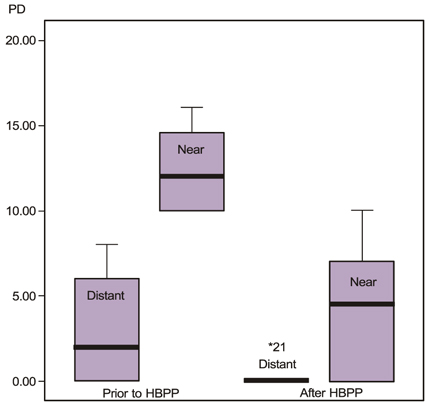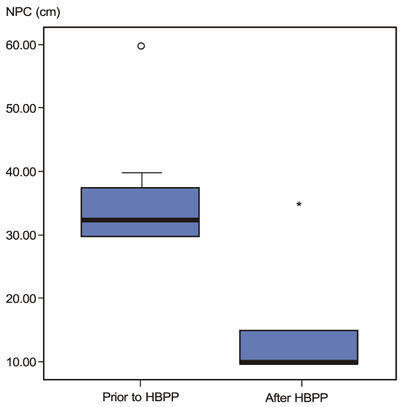Korean J Ophthalmol.
2011 Jun;25(3):185-188. 10.3341/kjo.2011.25.3.185.
Effectiveness of Home-Based Pencil Push-ups (HBPP) for Patients with Symptomatic Convergence Insufficiency
- Affiliations
-
- 1Department of Ophthalmology, Kyungpook National University School of Medicine, Daegu, Korea. byjun424@hotmail.com
- KMID: 1010026
- DOI: http://doi.org/10.3341/kjo.2011.25.3.185
Abstract
- PURPOSE
To report the effectiveness of home-based pencil push-ups (HBPP) therapy for patients with symptomatic convergence insufficiency.
METHODS
Data was collected prospectively on 16 patients who were diagnosed with convergence insufficiency beginning in January 2009. The study group was composed of ten male and six female patients. The duration of symptoms, refractive error, distant and near deviation angles, and near point of convergence (NPC) prior to and after 12 weeks of HBPP therapy were measured in all patients.
RESULTS
The mean age of the patients was 19.3 years. The mean deviation angle of exophoria was 3 prism diopters (PD) at distant and 11.2 PD at near. The mean value of NPC prior to HBPP therapy was 36.3 cm; however, the near point of accommodation was within the normal range. After 12 weeks of HBPP therapy, the mean deviation angle of exophoria decreased to orthophoric at distant and 4 PD at near. The mean value of NPC decreased to 14.4 cm.
CONCLUSIONS
Twelve weeks of HBPP therapy appears to be an easy, cost-free and effective therapy for patients with symptomatic convergence insufficiency.
MeSH Terms
Figure
Cited by 1 articles
-
Clinical Manifestations and Prognosis of Convergence Insufficiency after Craniofacial Trauma
Min Ho Shin, Dae Hyun Kim
J Korean Ophthalmol Soc. 2015;56(10):1604-1609. doi: 10.3341/jkos.2015.56.10.1604.
Reference
-
1. von Noorden GK, Campos EC. Binocular vision and ocular motility: theory and management of strabismus. 2002. 6th ed. St Louis: Mosby;502–503.2. Daum KM. Convergence insufficiency. Am J Optom Physiol Opt. 1984. 61:16–22.3. Borsting EJ, Rouse MW, Mitchell GL, et al. Validity and reliability of the revised convergence insufficiency symptom survey in children aged 9 to 18 years. Optom Vis Sci. 2003. 80:832–838.4. Convergence Insufficiency Treatment Trial Study Group. Randomized clinical trial of treatments for symptomatic convergence insufficiency in children. Arch Ophthalmol. 2008. 126:1336–1349.5. Gallaway M, Scheiman M, Malhotra K. The effectiveness of pencil pushups treatment for convergence insufficiency: a pilot study. Optom Vis Sci. 2002. 79:265–267.6. Scheiman M, Cooper J, Mitchell GL, et al. A survey of treatment modalities for convergence insufficiency. Optom Vis Sci. 2002. 79:151–157.7. Scheiman M, Mitchell GL, Cotter S, et al. Convergence insufficiency: randomized clinical trial-reply. Arch Ophthalmol. 2005. 123:1760–1761.8. Scheiman M, Rouse M, Kulp MT, et al. Treatment of convergence insufficiency in childhood: a current perspective. Optom Vis Sci. 2009. 86:420–428.9. Scheiman M, Mitchell GL, Cotter S, et al. A randomized clinical trial of vision therapy/orthoptics versus pencil pushups for the treatment of convergence insufficiency in young adults. Optom Vis Sci. 2005. 82:583–595.10. Convergence Insufficiency Treatment Trial (CITT) Study Group. The convergence insufficiency treatment trial: design, methods, and baseline data. Ophthalmic Epidemiol. 2008. 15:24–36.11. Beecher HK. The powerful placebo. J Am Med Assoc. 1955. 159:1602–1606.
- Full Text Links
- Actions
-
Cited
- CITED
-
- Close
- Share
- Similar articles
-
- Near Point of Convergence of Normal Subjects and Convergence Insufficiency Patients
- Cost-Effectiveness Analysis of Home Health Care Program for Cerebrovascular Accident Patients
- Accommodation and Convergence, Anomalies of Convergence
- Treatment of upper ureteral stone with ESWL: push back effect
- The Ratio of Accommodative-Convergence to Accommodation in Patients with Intermittent Exotropia



